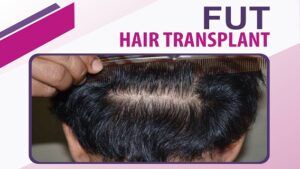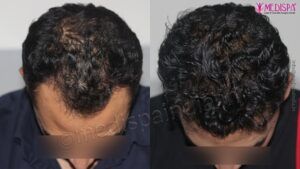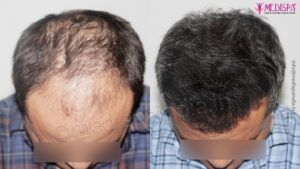
The field of hair transplantation is almost at its pinnacle because it can produce results that are completely natural. There has been much effort put into making the hair transplant procedure as efficient and comfortable for the patient as possible. We must employ the most recent methods in order to make the process seem as natural as possible.
The increasing prevalence of hair loss in both men and women has made hair transplantation one of the most popular cosmetic procedures. In the past, methods were antiquated and primitive, which led to ineffective results. Many thanks to the studies and technologies that are continuously paving a successful path for people with hair loss in achieving the best results from hair transplants.
Why did the FUT and FUE combination technique develop?
Norwood grades VI and VII are advanced and extensive balding stages that result in a larger bald area and only leave a band of hair on the side and back of the head. To achieve an acceptable level of coverage of the bald area by hair transplant, these patients would require more follicular grafts. Even though the required number of grafts couldn’t be achieved using just the FUT or FUE hair transplant technique, a combination of the two emerged. Combination technique is a good way to perform hair transplants in cases of severe baldness because it allows for the extraction of more than 4000 follicular grafts.
Therefore, thanks to the development of combination techniques, cases of extensive baldness can now enjoy a pleasing hair coverage on their bald scalp.
The Medispa hair transplant clinic specializes in combining the FUT and FUE techniques, and it has treated a large number of patients with the best possible aesthetic outcomes. In Delhi and Jaipur, PRP therapy using a combination technique was first introduced by Dr. Suneet Soni. He is well known throughout the nation for using a combination technique to achieve the best hair transplant results and the best coverage in cases of severe baldness.
Hair restoration
The most effective hair loss treatment, with long-lasting effects and a natural appearance, is hair transplantation. The shortcomings of other treatment options include their transience and unnatural appearance. A cosmetic surgical procedure called hair transplantation involves removing follicular units from the donor area and transferring them to the recipient’s bald area. The density of hair in DHT-resistant regions, such as the back and sides of the head, as well as body hairs, are taken into consideration when selecting the donor site.
Methods for hair transplantation
Two current techniques are used for hair transplantation, but they differ in how the grafts are harvested. The hair transplant procedures are as follows:
Hair transplant using the FUT (follicular unit transplantation, or strip method): In the FUT hair transplant procedure, a strip of scalp tissue is taken out and dissected to cut individual grafts. The recipient’s bald spots are then filled with individual grafts.
Hair transplant using FUE (Follicular Unit Extraction): With a surgical tool resembling a punch, individual hair follicles are extracted during a FUE hair transplant. The recipient’s bald spots receive a transplant of hair follicles from the donor.
These hair transplant procedures are picked based on the degree of baldness, the patient’s age, gender, the number of grafts available or needed, and the density of the hair in the donor areas, among other factors. Each technique has a unique set of criteria upon which it is selected.
What are the indications for using the FUT+FUE combination technique?
Although FUT and FUE have some uses and restrictions, they are both the best available today. However, both techniques appear ineffective in cases of extensive baldness like Norwood grade VII case because they could not produce enough grafts when used alone. From this point forward, combination technique is considered to be a highly effective modality in complex cases. Without encroaching on the safe donor area, it could provide harvesting of more than 4000 grafts in a single mega session.
Several of the indications for the combination technique are listed below, including:
- When there is significant baldness and more grafts are needed
- If the donor area is not sufficiently dense
- Pattern baldness, which tends to get worse as people age
- High density hair transplant demand
- Natural results are demanded for advanced baldness
Medispa hair transplant clinic is a leader in providing top-notch natural results. We have state-of-the-art machinery, a clean operating room, the largest graft segregation room in India with a video assisted microscope, and the largest team for hair transplant in India. International hygienic standards have been upheld throughout our clinic, including in the operating room. Dr. Suneet Soni is renowned for his sincere advice and good judgment when it comes to selecting the best course of action while carefully considering all of the advantages and disadvantages. Our team is very productive and provides the best hair transplant results in the shortest amount of time.
What purpose does the FUT and FUE combination technique serve?
- The combined procedure has the additional advantage of enabling the harvesting of up to 4000 follicular grafts, which is not possible with either technique by itself. A 3000–3500 graft harvest is possible with the FUT hair transplant technique, while a 1500 graft maximum is possible with the FUE method.
- The combination procedure enables the preservation of follicular units for subsequent sittings in cases of progressive hair loss.
- Scarring from this procedure is essentially undetectable. A thin strip is removed during the FUT procedure, and the sutures are then placed using a complex method called trichophytic closure, which enables almost imperceptible scarring. With the FUE procedure, the follicles are removed at a distance, virtually hiding the circular scars.
Make an appointment with Medispa to fulfil your dream if you have severe baldness and want the best outcomes.







